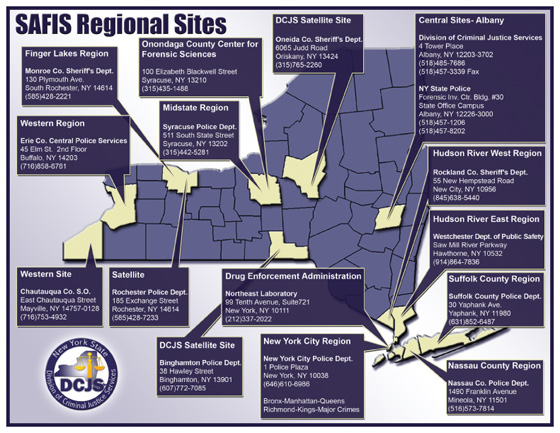Latent Search Service
The New York State Division of Criminal Justice Services (DCJS) initiated the latent fingerprint database of the Statewide Automated Fingerprint Identification System (SAFIS) in 1989, when it began automated latent fingerprint searches. The Latent Cognizant database contains the records and fingerprint images of approximately 3,000,000 individuals. This database is a sub-system of the Tenprint record database, which contains over 7,000,000 criminal and civil records. The Tenprint and Latent Cognizant databases constantly change with the addition of new records, updates to existing records, or deletions (sealing) of records.
Cases can enter the latent system via two central sites in Albany and nineteen regional sites around the state. Each latent image is evaluated by a trained Latent Examiner. A determination is made as to whether the image is “of value,” i.e., has enough identifiable minutiae to launch a search on SAFIS. If the image is determined to be of value, a search of the Latent Cognizant database is initiated.
After all latent fingerprints have been entered, the Latent Examiner compares candidates returned by SAFIS, and makes the determination if the latent image matches any of the candidates.
After searching is complete, latents not identified may be added to the Unsolved Latent Database and the images are archived in the Digital Image Retrieval Subsystem. All new arrest fingerprint cards received are automatically searched against this file daily.
Since November, 2005, DCJS has the ability to search latent palm prints against NYPD’s database of approximately 500,000 known palm prints and store them in NYPD’s unknown palm print database if an identification is not determined.
Did you know?
- Statewide, approximately 21,000 latent identifications have been made since 1989.
- Search results are usually available for review by examiners within 24 hours.
- Everyday, on average, over 500 new fingerprint cards are added to our fingerprint database and automatically searched against our unidentified latent fingerprint database.
- Latent fingerprints can be submitted by mail or in person to your own Regional Site or to the Central Site at DCJS.
- You do not need a suspect to submit latent fingerprints to SAFIS.
- Newly entered latent fingerprints can be searched directly against the Unsolved Latent Database to determine the possibility of a serial offender in multiple jurisdictions.
- Unidentified latent fingerprints are held in a separate database for continuous searches against new arrest fingerprints.
- A Latent Examiner defines the latent search parameters (e.g. geographical area of search, crime type, race, sex, pattern type, etc.).
- New coders and matchers have been installed to improve processing speed and accuracy.
- The FBI's Integrated Automated Fingerprint Identification System (lAFIS) went online in 1999. New York was the first state to perform remote searches of this nationwide file of 600 million fingerprint images.
